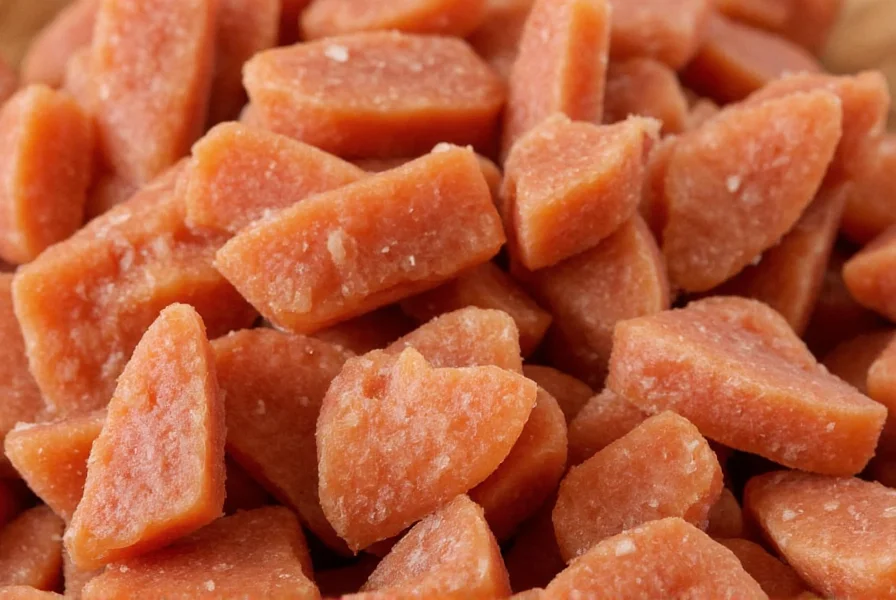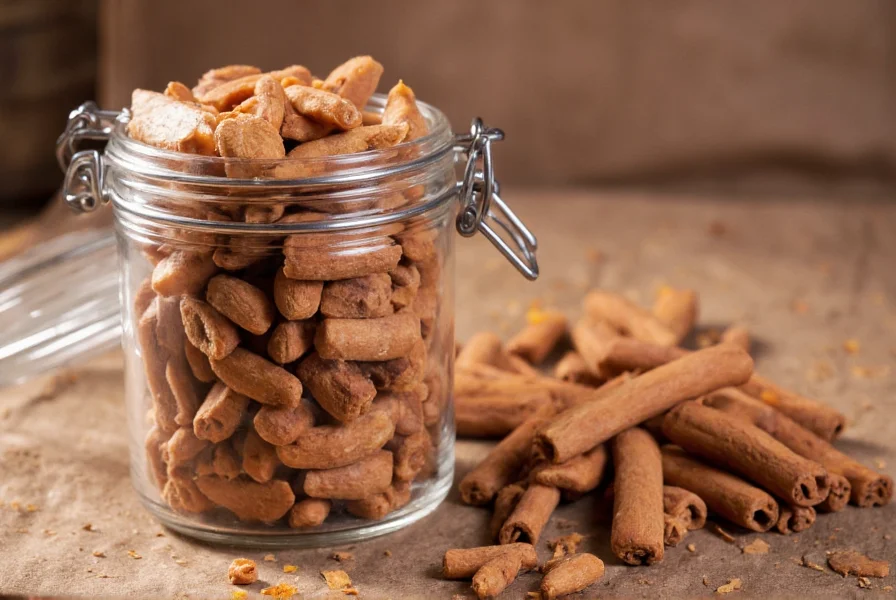Hard cinnamon candy is a boiled sweet made from sugar, corn syrup, water, and cinnamon flavoring, characterized by its intense spicy flavor and firm texture that slowly dissolves in the mouth. The candy reaches its signature hardness when sugar syrup is boiled to the "hard crack" stage (300-310°F or 149-154°C) before adding cinnamon and cooling.
For candy enthusiasts and curious snackers alike, hard cinnamon candy represents one of the most distinctive confections in the world of sweets. This classic treat delivers an immediate burst of spicy warmth followed by a gradual cooling sensation as it dissolves slowly in the mouth. Unlike softer candies that melt quickly, hard cinnamon candy maintains its structure while releasing flavor over an extended period—typically 15-20 minutes of sustained enjoyment.
The unique sensory experience comes from the specific chemical composition of cinnamon oil, primarily cinnamaldehyde, which creates that characteristic burning sensation followed by cooling. This dual-phase flavor delivery makes hard cinnamon candy particularly appealing to those who enjoy intense flavor experiences without the fleeting nature of softer candies.
The Historical Roots of Hard Cinnamon Candy
While candy-making traditions date back centuries, hard cinnamon candy as we know it emerged in the late 19th century when advances in sugar refining made consistent hard candy production possible. Cinnamon itself has been prized for millennia—ancient Egyptians used it in embalming, while medieval Europeans valued it as both a spice and medicinal remedy.
The first commercial hard cinnamon candies appeared in American and European markets around the 1880s, coinciding with the industrialization of candy production. These early candies used natural cinnamon oil extracted from Ceylon or Cassia bark, creating the intense flavor profile that remains popular today. Unlike modern fruit-flavored hard candies, cinnamon maintained its position as a specialty item due to its distinctive, acquired-taste profile.
Ingredients and Manufacturing Process
Authentic hard cinnamon candy requires precise formulation and temperature control. The basic ingredients include:
| Ingredient | Function | Typical Percentage |
|---|---|---|
| Granulated sugar | Primary structure and sweetness | 60-65% |
| Corn syrup | Prevents crystallization | 30-35% |
| Water | Solvent for cooking process | 10-15% |
| Cinnamon oil | Flavor and characteristic burn | 0.5-1.5% |
| Coloring (optional) | Visual appeal | Trace amounts |
The manufacturing process follows precise temperature stages:
- Mixing: Sugar, corn syrup, and water combine in large kettles
- Cooking: Mixture heats to 300-310°F (149-154°C) - the "hard crack" stage
- Flavoring: Cinnamon oil added after removing from heat
- Coloring: Reddish-brown hue introduced (natural or artificial)
- Molding: Poured into molds or pulled and cut
- Cooling: Hardens at room temperature over several hours
- Wrapping: Individual pieces wrapped to prevent moisture absorption
Temperature control proves critical—even a 5-degree variance affects the candy's final texture. Undercooked candy remains too soft, while overheated candy develops caramelization that alters both flavor and color.

Regional Variations and Brand Differences
While the basic formula remains consistent, regional preferences have created distinct variations of hard cinnamon candy:
- American style: Typically brighter red with stronger artificial cinnamon flavor
- European style: More subdued color with emphasis on natural cinnamon oil
- Mexican style: Often incorporates chili powder for added heat
- Asian variations: Sometimes blended with other spices like clove or star anise
Brand differentiation primarily occurs through:
- Cinnamon oil concentration (affecting burn intensity)
- Color saturation (from pale amber to deep red)
- Additional flavor notes (some include wintergreen for cooling effect)
- Shape and size variations (round discs, squares, or novelty shapes)
For those seeking authentic homemade hard cinnamon candy, the process requires careful attention to temperature and ingredient ratios. Many candy makers recommend using a candy thermometer rather than relying on visual cues alone, as the margin for error proves narrow when achieving the perfect hard candy consistency.
Storage and Shelf Life Considerations
Proper storage significantly impacts hard cinnamon candy's longevity and quality. Being hygroscopic, these candies readily absorb moisture from the air, which causes them to become sticky and lose their characteristic hardness.
For optimal preservation:
- Store in airtight containers away from humidity
- Maintain temperatures below 70°F (21°C)
- Include silica gel packets to absorb ambient moisture
- Avoid direct sunlight which can cause flavor degradation
Well-stored hard cinnamon candy typically maintains quality for 6-12 months. Signs of deterioration include:
- Surface stickiness or tackiness
- Cloudiness or crystallization
- Diminished cinnamon flavor intensity
- Off tastes from flavor compound breakdown

Understanding Cinnamon Candy's Unique Sensory Profile
The distinctive experience of hard cinnamon candy comes from the interaction between cinnamaldehyde (the primary compound in cinnamon) and sensory receptors. Initially, cinnamaldehyde activates TRPA1 receptors responsible for the burning sensation, followed by activation of TRPV1 receptors that create warmth. As the candy dissolves, these compounds gradually release, creating the prolonged flavor experience.
This sensory progression explains why many people describe hard cinnamon candy as having "layers" of flavor—the initial intense burn gives way to warming notes, then subtle sweetness as the sugar base dissolves. The slow dissolution rate of hard candy allows these flavor transitions to occur gradually rather than all at once.
Frequently Asked Questions
Why does hard cinnamon candy burn my mouth?
Hard cinnamon candy creates a burning sensation due to cinnamaldehyde, the primary compound in cinnamon. This chemical activates TRPA1 receptors in your mouth that typically respond to irritants, creating that characteristic spicy burn. The intensity varies based on cinnamon oil concentration, with higher quality candies using more natural cinnamon oil producing a more pronounced effect.
How can I make hard cinnamon candy at home without special equipment?
You can make hard cinnamon candy at home with basic kitchen equipment. You'll need a heavy-bottomed saucepan, candy thermometer, wooden spoon, and baking parchment. The key is maintaining precise temperature control—cook sugar syrup to exactly 300-310°F (149-154°C) before adding cinnamon oil. Without a thermometer, use the cold water test: drops of syrup should form hard, brittle threads that crack when bent.
What's the difference between hard cinnamon candy and cinnamon gum?
Hard cinnamon candy and cinnamon gum differ fundamentally in composition and experience. Hard candy is sugar-based with cinnamon flavoring, designed to dissolve slowly while releasing flavor. Cinnamon gum contains a gum base that doesn't dissolve, allowing for extended chewing. Hard candy delivers intense initial flavor that gradually diminishes, while gum provides more consistent but less intense flavor throughout chewing.
Why does some hard cinnamon candy turn my mouth numb?
The numbing sensation some experience with hard cinnamon candy comes from cinnamaldehyde's interaction with sensory receptors. After the initial burning phase, cinnamaldehyde can temporarily desensitize nerve endings, creating a mild numbing effect. Higher quality candies with more natural cinnamon oil tend to produce this effect more noticeably than those using artificial flavoring. This sensation is temporary and harmless, typically resolving within 15-30 minutes after finishing the candy.
How do I prevent hard cinnamon candy from sticking to my teeth?
To prevent hard cinnamon candy from sticking to teeth, ensure it's properly cooked to the hard crack stage (300-310°F). Undercooked candy remains too soft and sticky. Store candy in dry conditions with silica gel packets to prevent moisture absorption, which makes candy tacky. Consuming the candy slowly allows saliva to gradually dissolve it, reducing adhesion. Drinking water while enjoying the candy also helps wash away residual sugars before they can stick.











 浙公网安备
33010002000092号
浙公网安备
33010002000092号 浙B2-20120091-4
浙B2-20120091-4